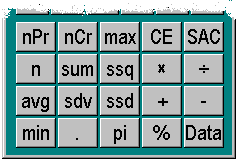Statistical Functions
To access the statistical functions, make sure you are in Statistics mode; the title bar should end with [stats]. If not, click mode and select Statistics from the Number/Mode group. In statistics mode, the bottom right hand button on the calculator is data. To input values for analysis, enter numbers and click data after each number is input. Repeat this process until you have entered all the data values. If you press the shift button on the calculator, some of the number keys change to the statistics functions:
For example, to get the number of points entered, press ![]() ; to get the mean of the data, press the
; to get the mean of the data, press the ![]() button.
button.
To clear the statistics memory, press shift and then press SAC (Statistics All Clear) button (which was labelled AC before pressing shift).
 - Data Input
- Data Input
To input values for analysis, enter numbers and click data after
each number is input. Repeat this process until you have entered all the
data values.
 - Statistics All
Clear
- Statistics All
Clear
To clear the statistics memory, press the shift button, followed
by SAC (i.e. shifted AC).
 - Permutations
- Permutations
Computes the number of permutations nPr.
Example:
To compute the number of ways of arranging five objects chosen from
a population of ten:
1 0 shift ![]() 5 =
5 =
Result: 30240
Note: The calculator must be in statistics mode.
 - Combinations
- Combinations
Computes the number of combinations nCr.
Example:
To compute the number of combinations of five objects chosen from a
population of ten (without regard to the order of choosing):
1 0 shift ![]() 5 =
5 =
Result: 252
Note: The calculator must be in statistics mode.